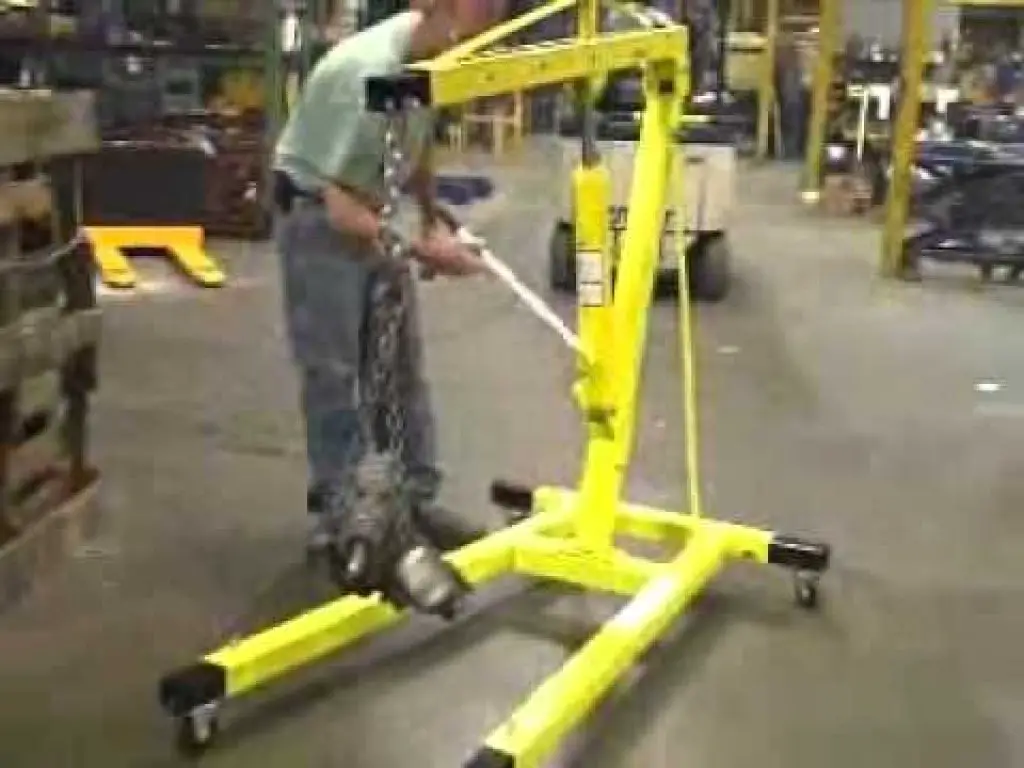We hope you love the products we recommend and just so you know that as an Amazon Associate EngineHoist.net may earn from qualifying purchases.
Chain size selection for your engine hoist is really important.
As someone who has worked with a number of engine hoists, I’ve learned that knowing what size chain to use for an engine hoist is key to both safety and efficiency.
Your engine hoist chain needs not only to support the weight of the engine but also to withstand the rigors of the lifting process.
So what size chain for engine hoist should you be looking for?
One of the key considerations when selecting a chain size for an engine hoist is the engine’s weight. You need to be confident that the engine hoist chain can support the engine’s weight without breaking or failing.
Furthermore, the chain must be robust enough to withstand the forces exerted during the lifting and lowering process.
The length of the chain is another crucial factor – a chain that’s too long or short can cause issues during the engine lifting operation.
Table of Contents
Determining What Size Chain for Engine Hoist You Need

I remember preparing to use my engine hoist and realizing I didn’t know what size chain to use. After a bit of research, I discovered that figuring out the right chain size for an engine hoist is quite straightforward. Here are the steps I took:
How to Measure Your Engine Hoist for the Right Chain Size
The first step in determining the right chain size for your engine hoist involves measurements. Measure the distance from the boom’s center to the ram’s center.
This measurement will be your “reach.” Then, measure the distance from the boom’s center to the load hook’s center. This measurement is your “height.”
Using the Manufacturer’s Manual to Determine What Size Chain for Engine Hoist You Need
Once you’ve taken these measurements, consult the manufacturer’s manual for your engine hoist. This manual should provide a chart that matches the reach and height measurements with the correct chain size for the engine hoist.
If you don’t have the manual, you can contact the manufacturer directly (generally via their website), and they should be able to provide you with the appropriate chain size based on your measurements.
Considering the Weight Capacity of the Chain for Your Engine Hoist
One crucial consideration when selecting a chain for your engine hoist is the chain’s weight capacity. The chain you choose must safely support the weight of the engine you’re lifting. Selecting a chain with a weight capacity that’s too low could lead to it breaking under the engine’s weight, causing serious injury or damage. Conversely, a chain with a higher than necessary weight capacity could mean overpaying for a heavier, more costly chain.
Choosing the Right Chain Material for Your Engine Hoist
Another factor to consider when selecting a chain for your engine hoist is the chain material. Chains can be made from a variety of materials, including:
- steel
- alloy
- stainless steel
When choosing the right chain for your engine hoist, one of the key factors to consider is the material of the chain. Different chain materials come with distinct sets of properties, such as strength, durability, and corrosion resistance, which are all crucial to ensure the safe and efficient operation of your engine hoist.
Generally, the three primary materials used in chains are steel, alloy, and stainless steel. However, another type of chain material that has gained attention due to its unique characteristics is the nickel-plated chain.
Nickel-Plated Chains
Nickel-plated chains are known for their excellent reliability, safety, and functionality. The primary benefit of nickel-plating is its prevention of hydrogen embrittlement, a condition that can reduce the strength of chains when hydrogen molecules penetrate the chain material. This added protection makes nickel-plated chains particularly well-suited for industries with demanding applications, such as the windmill and offshore industries.
Another significant advantage of nickel-plated chains is their increased corrosion and abrasion resistance compared to traditional zinc-plated chains. This superior resistance to rust is particularly vital as rust leads to metal degradation, which can increase the risk of chain breakage and the subsequent need for chain replacement.
Moreover, nickel-plated chains showcase a high breaking strength, ranging typically from 800 to 1000 N/mm2. These chains also offer additional advantages such as wear resistance and longer service life, contributing to overall lower maintenance needs.
High Tensile Steel Chains
High tensile steel is a common material used in chains. However, it is known to suffer from an issue called hydrogen embrittlement. This phenomenon reduces the steel’s strength when zinc electro-plating absorbs hydrogen into the steel. This issue is countered in some chains by using manufacturing processes that generate less hydrogen and effectively eliminate absorbed hydrogen.
Be it steel, alloy, stainless steel, or nickel-plated chains, each material has unique properties that can greatly affect the performance of your engine hoist. It’s crucial to understand these properties to choose a chain that best suits your specific engine hoisting needs.
Determining the Right Length of the Chain for Your Engine Hoist
The chain length is another essential aspect when choosing a chain for your engine hoist. Ensure the chain is long enough to reach the engine but not so long that it’s challenging to manage or becomes a safety hazard. Chain length can also affect the chain’s weight capacity – longer chains may not support as much weight as shorter ones.
In conclusion, when selecting what size chain to use for your engine hoist, it’s important to consider the chain’s weight capacity, chain material, and length. By considering these factors, you can select a chain that ensures the safety, effectiveness, and efficiency of your engine hoist operations.








